- Home
- Eric Nylund
Halo: Evolutions - Essential Tales of the Halo Universe Page 15
Halo: Evolutions - Essential Tales of the Halo Universe Read online
Page 15
to strive
A million stars between here and home
A million enemies; more
Yet here he stands, ever vigilant
And here he’ll stay;
A lone warrior, on a desolate plain
HEADHUNTERS
* * *
JONATHAN GOFF
ONE
_______________
BLOOD, BULLETS, AND ADRENALINE
* * *
“Hey!”
The word just hung there for an instant as Jonah gave his motion sensor a second glance.
“I got one,” the excitement in his hushed voice unmistakable.
“You sure?” Roland had just about enough of false alarms.
“Pretty sure,” Jonah shot back.
There was a split second when the world came to a complete stop—silent and unmoving.
“Nope—yeah, I’m sure,” Jonah confirmed.
If he was right, and Roland desperately hoped he was, then it would be the first contact with enemy forces since their insertion into the field some six days prior. In that time the pair had covered twenty-three miles, at times moving at a snail’s pace as they crept ever closer to their target.
“This is fun,” Jonah concluded, the excitement in his voice escalating.
“It’s about to be, anyway.” Roland had never much enjoyed this part of the job—the sneaking around, the long days and hours spent maintaining absolute cover while maneuvering behind, through, and between enemy lines—but what came after, the blood, bullets, and adrenaline, that he enjoyed quite a bit, maybe as much as Jonah, though probably not. Jonah had the added benefit of loving every minute in the field. Not just the combat, but the whole ordeal, from insertion into each new alien hotspot to the postcarnage report back at home base—whether he was facedown in the mud and muck for twelve hours straight, silently sliding his custom combat knife across a Sangheili throat, or recounting the bloodshed wrought by the muffled rhythm of his M7S submachine gun, Jonah loved it all—every single second of life as one of the elite, as one of the UNSC’s top-tier Covenant killers.
TO HUMANITY at large, Jonah, Roland, and their fellow Spartan-IIIs were ghosts, their missions and movements deemed highly classified—top secret. Their very existence was known only by a select few, and while their brothers and sisters in the Spartan-II program earned glory and unwavering respect as they fought and died against the Covenant, the IIIs fought, and most certainly died, with only the recognition and admiration of their fellow secret warriors as their reward—for the Spartan-IIIs, however, as with the IIs, this was more than enough. Though created under comparable, yet varied circumstances, the two forces shared one very similar mind-set: Duty first. Loyalty second. In the Spartan mind petty vices such as fame simply did not register. There was no need for the galaxy-wide adulation of the masses reveling in their many brutal victories over the Covenant. Nor did they want the sympathies and pity of anyone outside their close-knit circle when they were confronted by defeat—by death. This secrecy helped bond each Spartan-III unit like those of no other unit, and in truth it was something they appreciated—cherished, even. After all, with attention comes distraction, and in a war against a collection of advanced alien races hell-bent on slaughtering the whole of humanity, there was no room for wandering thoughts or clouded minds.
As tools of war, the Spartan-IIIs were most often deployed as living fire-and-forget weapons—just point, shoot, and wait for the fireworks. ONI, or on occasion a highly placed UNSC official, passed along a key Covenant target; the IIIs were then sent in, headfirst, to eliminate the given objective, or inflict as much damage as physically possible in the effort. Success meant a handful or more made it back to base, mission complete; failure, nobody came home, but—to a man—they fell doing their damnedest to inflict the maximum level of destruction upon their foe. This all-encompassing sense of service before self in the face of almost certain death hardened them. Connected them. But even among this collection of steadfast soldiers there were a select few with a bond deeper than the others could ever begin to imagine, as these unique IIIs were a secret even to their peers.
AND SOMEWHERE out among the star-poked black of the galaxy, on a nameless moon, far beyond the outermost UNSC colony, Roland and Jonah methodically inched their way through tangled, alien undergrowth, slowly, quietly moving closer to the source of the blip on Jonah’s motion tracker.
TWO
_____________
A BRIEF HISTORY OF HEADHUNTING
* * *
There had been much concern about fielding a sufficient number of Spartans for the missions that were considered essential—deployment against large-scale Covenant targets and defense of key UNSC facilities being chief among them. In a war many were beginning to believe was unwinnable, losing even a handful to specialized operations was frowned upon. This unwillingness to spread the Spartan ranks too thin across the field of battle meant the number of two-man infiltration squads, codenamed: Headhunters, culled from the ranks of the Spartan-III program, was extremely limited. At the program’s height there was a maximum contingent of six squads—six teams, with a total of seventeen soldiers rotating in to fill gaps when half or all of a team was lost in the field. Jonah and Roland were paired as part of an initial eight-man roster and had been together as a unit since.
It was the Headhunters’ task to infiltrate heavily fortified enemy encampments, ships, and operation centers completely undetected, with minimal, mission-specific weaponry, and no radio contact or hope for backup or retrieval, and complete a set series of objectives in preparation for one of two eventualities: a larger, full-scale assault on the target, or as a decoy and distraction for UNSC operations elsewhere.
Over the course of the Human-Covenant War there had been some luck, limited but occasionally fruitful, in stealth insertions behind Covenant lines. The majority of these operations ended in lost contact with the field unit and the presumed death of the operatives involved. The Spartan-II program had changed this to a degree, as the IIs had been able to slip into enemy territory on a number of occasions—not always with the best results, but with results, nonetheless. Now, with the IIIs and the advancements in their training and the technologies and equipment available to them, further and more intrusive campaigns into Covenant-held regions were deemed a necessary risk—although such operations would be attempted on a limited basis, and in direct control of a special unit from deep within Beta-5, one of ONI’s most secretive subdivisions, operating under the umbrella of the clandestine organization known as Section Three.
Spartan-III soldiers selected to participate in the Headhunter program had to meet one exclusive prerequisite before being considered by Beta-5: only those individuals who had survived two or more specially assigned training missions would be evaluated for possible inclusion in its additional, grueling training regimen. Once an overall list of potential candidates was compiled, each trooper’s personal files and mission reports—from birth all the way up to, and including, their activities within the past twenty-four hours—were analyzed against a set series of parameters calculated by top ONI specialists.
Both Roland and Jonah not only fell under the “two missions” banner of acceptance, they were perfect matches for each of Beta-5’s requirements, and more importantly, when offered the opportunity to participate—though presented with only the vaguest of program overviews—they each leapt at the chance to hit back at the Covenant in new and unexpected ways.
Once selected, candidates were separated from their fellow Spartans and shipped to a special training facility on the far side of Onyx, the ONI-controlled world that served as the IIIs’ base of operations. After three months, the soldiers were broken into four two-person squads, chosen through a series of detailed evaluations and an intense interview process meant to devise the best possible pairings between members of the group. Roland and Jonah’s pairing hit on 97.36 percent of the desired matchmaking criteria; only one other team scored higher.
Now, more tha
n two years later, their training complete—including seven months of supervised field exercises, followed by six months’ real-world wartime insertions—and the successful negotiation of twelve battlefield insertions under their belts, Roland and Jonah found themselves on the far side of the galaxy, two human soldiers on a moon crawling with Covenant. Their current task was straightforward enough—slip onto the Covenant-held moon, believed to be the site of one of the pious alien collective’s sacred religious digs, and remove six of the ten identified base camps situated around the outer perimeter of a much larger central compound. A second team of Headhunters would remove the four outstanding camps in preparation for what was to follow. The confusion and re-shuffling of troops and supplies by the Covenant contingent following each base camp’s dismantling was simply the opening salvo in a full-scale assault by a dozen Spartan-III fireteams and associated orbital backup.
THREE
_________________
APES OR ALLIGATORS?
* * *
The indicator on Roland’s individual radar showed that whatever their contact—Grunt or Elite, Jackal or Brute—they were less than ten meters from it, and while he and Jonah were careful not to give away their position as they crept closer, they had yet to establish visual confirmation of their target. In the post-dusk hour it was possible the Covenant sentry was using the shadows of the forest to conceal its perch as it stood guard over the base camp’s perimeter. It was just as likely, however, that the bastard was hidden beneath the light-bending cloak of active camouflage. One option pointed toward a raptorlike Kig-Yar sniper posted somewhere up in the thick tangle of branches that made up the forest’s canopy. The other, less appealing, option meant one of the Sangheili Elite, the Covenant’s most devout and dangerous warriors, was patrolling this sector of the perimeter.
Each possibility brought with it its own set of complications. The two Spartans ran through the encounter scenarios as they worked to develop a proper plan of attack: Shooting a sniper from its roost could draw unwanted attention. They could miss the kill-shot, alerting the creature to their presence and giving it the opportunity to signal an alarm. Or, even with a clean kill, the force of the impact and the pull of gravity might send the body tumbling from its resting place, bouncing off and snapping any number of branches along the way, before slamming into the ground with a thud that was sure to carry in the still night air. Taking out a camouflaged Elite in close combat meant dealing with the combined might of the alien’s armor, firepower, and brute strength. An Elite patrol usually carried one standard-issue Covenant plasma rifle, if not two, possibly a plasma pistol for backup, as well as plasma grenades, and if Roland and Jonah were particularly unlucky, an energy sword.
To top it all off, they’d have to find the damn thing before it found them.
Roland motioned for Jonah to freeze; they weren’t proceeding until they could confirm the identity of the obstacle and ascertain the best approach to removing it from their path.
“Think it’s av-cam,” Jonah whispered.
Roland didn’t respond.
The modified helmet-to-helmet vocal systems in their headgear meant they could speak to one another without fear of giving away their position, though in most cases, once they entered the combat zone, their instincts would take control and they would begin functioning solely on physical cues and intuition.
The UNSC had spent years sanctioning research and development into, and thrown an unspecified amount of resources at, the problem of active camouflage, or av-cam, replication. The ability to essentially disappear into your surroundings was a major advantage for the Covenant—in addition to their already terrifyingly superior weaponry and shielding and their uncanny mastery of slipspace navigation.
Officially, all UNSC efforts to prototype a working av-cam unit had been met with failure. Unofficially, as was the norm within Beta-5, they had been testing a modified version of active camouflage since the inception of the Spartan-III program, along with advanced vision modes that would allow for easier detection of stealthed enemy combatants.
While the field operable av-cam-enhanced armor variants were yet to be placed in UNSC-normal rotation, and were in fact quite limited even within the ranks of the Spartan-IIIs, the research into visor-based vision enhancements as part of an overall equipment upgrade known as Visual Intelligence Systems, reconnaissance, or VISR, was well underway, with the hope it could be made available UNSC-wide in the near future.
As with most research and development efforts with battlefield implications, VISR was already being field-tested by most Headhunter teams.
As it stood, Roland’s power armor was equipped with one of ONI’s experimental active camouflage units, along with a dedicated power supply. When it was activated he would achieve a state close to invisibility for a period of three and a half to four minutes.
Once used, however, the cell powering the unit would need anywhere from ten to fifteen minutes to recharge, and put an additional strain on his suit’s other power functions. Shielding. Bios. Targeting. Tracking. All of it would run at less than optimum efficiency while the av-cam system rebooted. Less than four minutes of maximized stealth in exchange for limited resources for a short—but long enough—duration, directly following. As such, Roland had to be judicious with its use.
“I think it’s av-cam,” Jonah continued, undeterred by Roland’s lack of response. “Could be a sniper.” He paused. “But I got twenty credits on it being camo.” He slid up alongside Roland. “Wanna take that bet, Rolle? Twenty cred? I’ll take camo. You can have the field.”
Jonah had seemed eager enough when he first signaled the contact, but the fact that he was getting chatty told Roland that his partner was becoming antsy—his need for violent release growing exponentially by the minute.
“Well, wha’d’ya got?”
“Don’t know,” Roland responded, after spending a couple seconds examining the blip on his tracker—it hadn’t moved since their first contact. “Stayin’ pretty still for a Slip-Lip,” Roland concluded, using a common dismissive referring to the four-pronged anatomy of the Sangheili mouth.
Jonah slowly moved his right hand up along the side of his helmet, flicking the small nub that activated his VISR mode enhanced vision. Roland followed suit. They each swept the forest floor with their gaze—the nighttime scene glowing with various hues as the VISR flickered into focus.
“I got nothin’.” Roland started.
The area where their target was positioned was clear of enemy presence. Steadily shifting their lines of sight to peer higher into the treetop, the two Spartans began scanning the forest canopy for their contact.
“Shit.” Jonah sighed before lowering his head, shaking it in disgust. “At the top. Right at one o’clock. All the way up.”
“Sniper,” Roland said plainly, without looking.
“Yep,” Jonah replied in mock defeat.
Roland smiled beneath his helmet and lifted his head.
Settled atop a small platform near the very top of the tallest cluster of trees in the area—just below where the forest met the sky—a lone Kig-Yar crouched, periodically tracking across the whole of the forest laid out before him with his trusty Covenant beam rifle, a sleek, long-range weapon that was extremely deadly in capable hands.
“How did that idiot not see us,” Jonah laughed.
“We’re that good,” Roland affirmed, gauging the distance between their position—belly-down on the forest floor—and the sniper’s roost high above, using his visor’s onboard electronics.
Roland waited a few breaths before adding, “More importantly . . . you owe me lunch.”
“Heh—a bet’s a bet,” Jonah conceded. “I’m more concerned with how we’re gonna get that jackass down from his nest without alerting the whole damn Covenant army.”
“We have a few options,” Roland began, his mind already catching on one idea in particular before Jonah cut back in.
“Why don’t you go ghost—climb up there and giv
e him a little tap—so we can get movin’,” Jonah nudged. He was definitely itching for a fight, and Roland couldn’t blame him. For all the waiting and slow going, it was these few moments before actual contact that were the most nerve-racking. All the work—the effort and energy—it took to cross vast stretches of unknown terrain unseen by the naked eye, and undetected by any number of tracking systems, was in anticipation of the handful of minutes spent face-to-face with your adversaries.
“This is exactly why I get to test out the cool new toys and you don’t,” Roland jabbed.
“How so?” Jonah shot back.
“This cam unit is a precious commodity,” Roland began to explain before Jonah pressed the issue.
“And?”
“And . . .” Roland continued diplomatically, “you’d activate it for no better reason than to give a Grunt a wedgie.”
“Fair point.”
“I, on the other hand, can control such base urges; saving our more limited, and valuable, assets for their appropriate use,” Roland explained with a mocking air of superiority in his voice.
“Geez, does that mean yer not gonna let me borrow the car this weekend, Dad?”
“You joke, but you know it’s true.”
“All right, all right . . .” Jonah was ready to get back on task. “You got a plan for this guy, then?”
Roland made sure Jonah could hear the joy in his response. “I was thinkin’ . . . lumberjack.”
THIRTY MINUTES later.
Roland and Jonah had no problems setting the shaped charges at the base of the Jackal sniper’s lookout and were back on course, slowly making their way to their main objective.
Knowing there would more than likely be multiple rotations between the snipers manning this particular perch before their attack on their first target would begin, the pair had taken extra care in concealing the explosives so as to avoid any unwanted attention. The real danger in leaving the sniper unattended hinged on the possibility that it would have a clear vantage point from which to draw a bead on them once they began their offensive, and while there were most assuredly other snipers in the area, their only immediate concern was in the reality of a known threat.

 A Thousand Drunken Monkeys: Book 2 in the Hero of Thera series
A Thousand Drunken Monkeys: Book 2 in the Hero of Thera series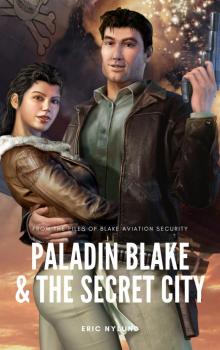 Paladin Blake & The Secret City
Paladin Blake & The Secret City A Thousand Drunken Monkeys
A Thousand Drunken Monkeys Halo: Evolutions - Essential Tales of the Halo Universe
Halo: Evolutions - Essential Tales of the Halo Universe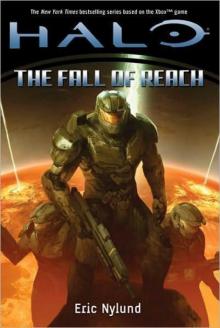 Halo: The Fall of Reach
Halo: The Fall of Reach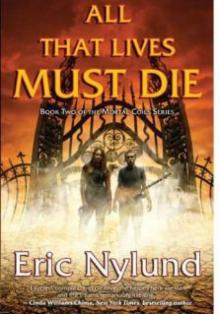 All That Lives Must Die mc-2
All That Lives Must Die mc-2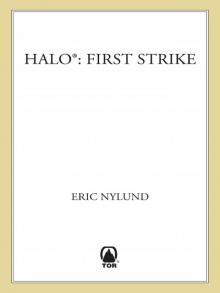 First Strike
First Strike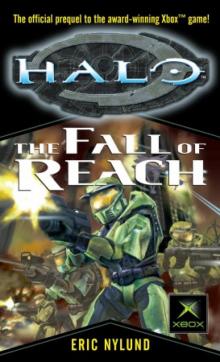 The Fall of Reach h-1
The Fall of Reach h-1